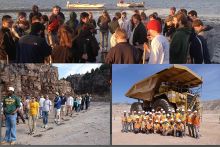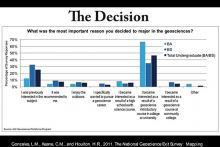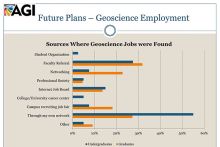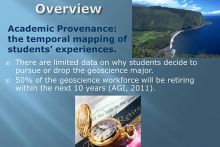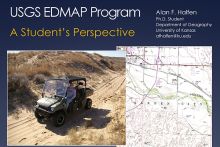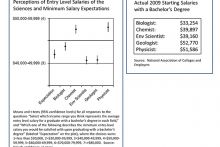Without properly targeted investment in the retention geoscience university students and the successful transition of geoscience graduates into core geoscience occupations, the sustainability of U.S. geoscience academic infrastructure and pursuit of basic geoscience research is at risk. This roundtable is a live web-cast that will commence with a brief presentation that highlights these main issues and will be followed by Skype chat-based discussion groups on the following topics. Roundtable moderators will present their discussion group summaries at the end of the roundtable session.
Roundtable Co-Sponsors: YES Network USA National Chapter, Soil Science Society of America, Australian Institute of Geoscientists
The geoscience profession is facing critical human resource issues as a result of its aging workforce and trickle of new graduates entering core geoscience occupations. Since the mid-1990's the geoscience degree completion rates have hovered near 12 percent for undergraduates and near 20 percent for graduate students. Furthermore, data from the National Science Foundation’s 2006 statistical databases indicates that only 30 percent of geoscience graduates work in core geoscience occupations. The majority of the geoscience workforce will be retiring over the next decade and data from federal sources, professional societies, and industry indicate this growing imbalance in the profession’s age demographics. Over the past three years, the age demographics for geoscientists in academia and the federal government indicate an acceleration in the loss of senior geoscientists from the profession.
Because of increasing pressure to address issues such as energy supply, climate and other environmental concerns, and as seen with the Japan disaster, strengthening hazard mitigation, there is an expected 23 percent increase in geoscience jobs over the next decade on top of a wave of nearly 50 percent of existing geoscientists retiring during the same time. The U.S. is beginning to see the loss of fundamental technical skills in the geoscience workforce, both within academia and in the applied sectors. Across all fields, future geoscientists will need solid fundamental skills in both geoscience and mathematics that can be applied to different geoscience challenges including water resources, energy, minerals, hazards and climate issues. Given the current trends, many core and specialty geoscience sub-disciplines that are also economically critical are at risk of extinction. Without properly targeted investment in the retention geoscience university students and the successful transition of geoscience graduates into core geoscience occupations, the sustainability of U.S. geoscience academic infrastructure and pursuit of basic geoscience research is at risk.
This roundtable is a live web-cast. The roundtable will commence with a brief presentation that highlights these main issues and will be followed by Skype chat-based discussion groups on the following topics.
Discussion group focus questions:
- How do we successfully retain geoscience students in US university programs?
- How do we successfully transition geoscience graduates into geoscience occupations?
Roundtable moderators will present their discussion group summaries at the end of the roundtable session.

